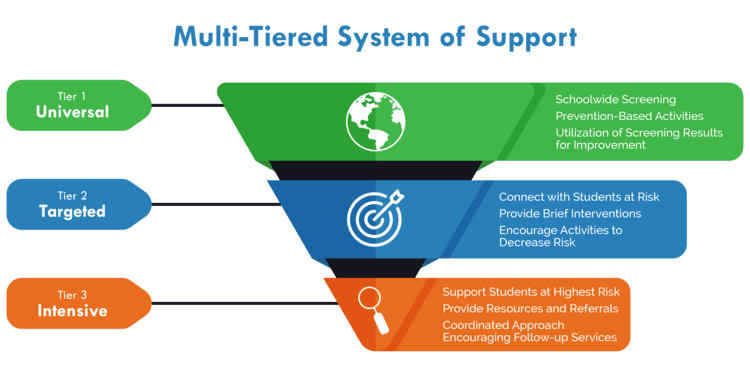Colorado public schools with students in grades 6-12 can take part in the Mental Health Screening Program. The program is funded by HB 23-1003 and overseen by the Colorado Behavioral Health Administration (BHA). The screening can help with unmet behavioral health needs by offering resources and support. Universal mental health screening in schools is best practice, and this program will support schools throughout the screening process.
Last updated: January 21, 2025
Mental health screening program information
Adolescence is a critical time for mental health, and schools play a major role in supporting the health of their students. The 6th-12th Grade Mental Health Screening Program allows public schools to improve the well-being and success of middle and high school students through an annual mental health screener. The screening program can be an important tool in addressing mental health needs for public school students.
Program Goal
The program's main goal is to identify behavioral health risks in students grades 6-12 and provide resources and referrals to address them. A mental health screener is not diagnostic. It can indicate whether or not there is a possibility of a mental health concern for a student. By addressing unmet behavioral health needs, the program aims to improve student readiness to learn and future academic success.
The screening provides a structure for identifying whole-group student needs like social-emotional development, self-regulation, and stress management. Additionally, the screener focuses on at-risk students who will receive relevant mental health resources, brief interventions, and staff follow-up.
Program benefits and impact
Healthy Kids Colorado Survey results from 2023 indicate that one in five students surveyed reported feeling sadness and hopelessness in the past year. Of the middle school students surveyed, 17% indicated that they have thought about suicide in the past year, and 42% of middle school and high school students surveyed felt that their stress levels were not manageable. These results indicate a need for mental health resources and support for students in Colorado.
Mental health is the largest determinant of a youth's overall health, wellbeing and academic success yet the Centers for Disease Control and Prevention (CDC) report that:
- Approximately one third of high school students report having serious thoughts of suicide.
- 40% of high school students have symptoms of depression
How the program helps students and schools
- Early identification of individualized needs: Screeners help identify students who may be struggling with anxiety, depression, or other challenges before they escalate to more significant issues and likely will lead to positive outcomes.
- Promoting resilience and success: Addressing mental health concerns proactively can improve academic performance, social and emotional skills, and overall well-being.
- Reducing stigma: When mental health screening becomes a part of school practices, they help normalize conversations around mental health by fostering a culture of support and acceptance.
- Connecting to resources: Screeners allow schools to connect students and families with resources, counseling, or intervention tailored to students’ needs.
- Identifying needs of the school population and larger community: The screening data can be used to inform tiered interventions and professional development needs in addition to informing overall school and district mental health policy. Community education needs may be identified by looking at the data from the student population, which can influence family engagement initiatives and assist schools in learning how to best support families/caregivers in understanding how to respond to youth behavioral healthcare risks and needs.
The screening program will:
- Screen students for the risks of anxiety, depression, suicidal ideation, substance use, and environmental factors that may impact their mental health.
- Provide HIPPA-compliant brief interventions, resources, and support tailored to individual student’s risk.
- Provide schools with the aggregate data that can be used to provide targeted support based on the identified needs of the student population.
- Notify parents and designated school professionals of students who are high risk within 24 hours of the screening.
- Provide targeted interventions for educators and parents to support student behavioral health needs.
School/staff information
A mental health screener can help to guide school-wide prevention and intervention strategies. A screener can also help support grant opportunities and show the need for more mental health or counseling staff.
4 ways mental health screeners help educators:
- Screeners empower educators. Screening is more effective, efficient, and less biased than relying only on teacher referrals.
- Students' struggles are identified. Screeners provide insight into students’ emotional well-being, helping educators identify those who may need additional support.
- Screeners can enhance classroom dynamics. Early identification and intervention are more likely to lead to positive student outcomes and less teacher time spent addressing behavior problems in the classroom.
- Screeners can reduce stigma and normalize mental health care. Routine screenings help create a culture where mental health is as important as physical health, reducing stigma and encouraging conversations.
How the program works in schools
We are using a high-tech, first-in-nation, trauma-responsive screening technology called Assessment Data Analytics Management (/\D/\M). /\D/\M screens for depression, suicide, anxiety, substance use, and social determinants of health that may impact student behavioral health. The screening provides a structure for identifying whole-group student needs like social-emotional development, self-regulation, and stress management. Additionally, the screener focuses on at-risk students who will receive relevant mental health resources, brief interventions, and staff follow-up.
Parents/guardians will receive written notice and information about the screener before students participate in the screening. Parents or guardians can opt their child out of the program, and students cannot choose to participate if opted out. Students can refuse to participate, even if their parent would like them to be screened..
Schools will need to designate a point of contact for the program who will share workflows, protocols, and other information to school staff. Schools will have access to an online training course for staff, plus webinars and case conferences with implementation information and resources.
Brief interventions and resources are provided to all students right after the screening, based on their individual results. A designated school professional will meet and follow-up with students identified as high risk. Students who have high risk may be experiencing thoughts of suicide, or answered questions on the screener that show high-risk factors for depression or anxiety. Parents of high-risk students will also be notified through text or email and given the same resources.
Screening data is aligned with Multi-Tiered System of Supports (MTSS)
Within MTSS, the screening data can be used to impact:
Tier 1 (Universal): Schoolwide screening for all students
Tier 2 (Targeted): Connect with students at risk
Tier 3 (Intensive): Support students at highest risk

Program onboarding/interest form for the 2025/26 School Year
Schools interested in participating in the 2025-2026 school year must fill out the interest form by May 1, 2025. Schools can choose to screen school-wide or select certain grade levels.
Schools that have questions about the program should contact Liz Schwemlein, Program Administrator for 6-12th Grade Mental Health Screening Program at elizabeth.schwemlein@state.co.us.
Parent information
The American Medical Association and the American Academy of Pediatrics recommend annual mental health and other risk screening for all youth. The 6th-12th Grade Mental Health Screening Program offers screening for Colorado public school students at participating schools. The screening tools used for this program are validated for youth and are commonly used in schools and healthcare offices. The tools contain questions that determine the risks of depression, suicide, anxiety, substance use, and environmental factors or conditions that may impact health and well-being.
Screening program information
Students will be screened for risks of depression, anxiety, suicidal ideation, and environmental factors that may impact their mental health. If your school is participating in the screening program a copy of the screening tool will be available for you to review on your school’s website. You may also view the screening questions here.
Screening program consent and privacy
Parents/guardians will get information about the screener before students participate in the screening. Parents or guardians can opt their child out of the program, and students cannot rejoin if opted out.
Our partner Possibilities for Change is committed to maintaining the confidentiality of all personal health information. They use a security platform for the screener that meets all Health Insurance Portability and Accountability Act) (HIPAA) and Family Educational Rights and Privacy Act (FERPA) requirements.
Results and intervention
Upon completion of the screening, all students will receive personalized brief interventions and resources through the online screening system. You will receive a text and/or email if your child’s screening results indicate high risk for depression, suicide, anxiety, or substance use and provided a link to information and resources. Designated school staff will follow up to offer additional support for your student. Students who are high risk for suicide will receive immediate intervention from designated school staff. These staff members will follow up with parents/guardians and follow the school’s crisis plan or suicide risk assessment protocol and response plan.
To help build a strong relationship for discussing any issues your child may face during their teen years, Possibilities for Change will provide you with access to Teen Speak® parent/guardian resources before the screening. These resources offer simple communication strategies for everyday talks and tough conversations.
Research shows that teens who talk with their parents engage in fewer risky behaviors. There are many ways to help your child reduce or avoid risks. Taking part in this screening can open the door to important conversations. Don't have just one talk—start early and keep talking about risky behaviors.
Need more information? Please reach out to your school administrator for more screening program details.
Resources
- HB23-1003: School Mental Health Assessment
- Program onboarding/interest form
- Mental health screening questions
- The 988 Colorado Mental Health Line is available for free, immediate, human support 24/7. If you or someone you know is struggling with an emotional, mental health or substance use concern, call or text 988, or live chat at 988Colorado.com.